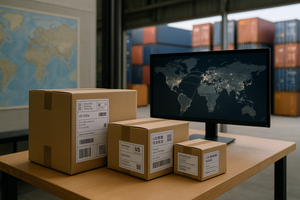The e-commerce landscape continues to evolve at a breathtaking pace, with new technologies, consumer behaviors, and global market dynamics reshaping how businesses sell online. As we look ahead to 2025, companies that want to stay competitive must adapt to these emerging trends or risk being left behind.
At Aries Star Marketing OPC, we work with e-commerce businesses across Asia, Europe, and the Middle East, giving us a unique perspective on the global digital retail landscape. In this article, we'll explore the most significant e-commerce trends that will dominate 2025 and provide actionable insights on how your business can capitalize on these developments.
1. Voice Commerce Takes Center Stage
Voice-activated shopping, once a novelty, is rapidly becoming mainstream. By 2025, we expect voice commerce to account for over $80 billion in retail sales globally. The increasing sophistication of AI assistants like Alexa, Google Assistant, and Siri, combined with growing consumer comfort with voice technology, is driving this shift.

For businesses, this means optimizing product listings for voice search by incorporating natural language patterns and conversational keywords. It also requires developing voice-specific user experiences that make browsing, comparing, and purchasing products as seamless as possible without visual interfaces.
"Voice commerce isn't just another channel—it's a fundamentally different way of interacting with customers that requires rethinking the entire shopping journey."
2. Augmented Reality Becomes Essential
Augmented reality (AR) is transforming from an interesting feature to a critical component of the online shopping experience. In 2025, consumers will expect to be able to visualize products in their own environment before making a purchase decision.
This is particularly important for categories like:
- Furniture and home décor - allowing customers to see how items will look in their space
- Fashion and accessories - enabling virtual try-ons for clothing, eyewear, and jewelry
- Beauty products - letting shoppers see how makeup will look on their own face
- Electronics - visualizing size and fit of devices in real-world settings
Our data shows that e-commerce sites implementing AR experiences see 40% higher conversion rates and a 30% reduction in return rates. The technology has become more accessible, with several platforms offering plug-and-play AR solutions that don't require extensive development resources.
3. Social Commerce Integration Deepens
The line between social media and e-commerce will continue to blur in 2025. Social platforms are no longer just marketing channels but have become complete shopping ecosystems where discovery, consideration, and purchase happen without ever leaving the app.

This trend is particularly strong in Asia, where platforms like WeChat and Instagram have pioneered seamless shopping experiences. However, we're seeing rapid adoption in Europe and the Middle East as well, with platforms adapting to local payment preferences and shopping behaviors.
To capitalize on social commerce, businesses should:
- Develop platform-specific strategies rather than using a one-size-fits-all approach
- Invest in creating shoppable content that feels native to each platform
- Leverage user-generated content to build trust and showcase products in real-world contexts
- Implement streamlined checkout processes that minimize friction
Regional Differences in Social Commerce Adoption
It's worth noting that social commerce adoption varies significantly by region. In our work across different markets, we've observed that:
- Southeast Asia: Leads in social commerce adoption, with over 45% of online shoppers making purchases through social platforms
- Middle East: Rapidly growing, with particular strength in fashion and luxury goods
- Europe: More cautious adoption, with privacy concerns playing a larger role in consumer behavior
4. Sustainability Becomes a Competitive Advantage
Environmental consciousness is no longer optional for e-commerce businesses. By 2025, sustainability will be a primary decision factor for over 60% of online shoppers. This extends beyond product materials to include packaging, shipping methods, and overall corporate practices.
Successful e-commerce businesses are implementing:
- Carbon-neutral shipping options
- Plastic-free packaging solutions
- Transparent supply chain information
- Circular economy initiatives like take-back programs

Our research shows that consumers are willing to pay a premium of 15-20% for products that demonstrate strong sustainability credentials, making this not just an ethical choice but a business opportunity.
5. AI-Powered Personalization Reaches New Sophistication
Personalization has been a buzzword in e-commerce for years, but in 2025, AI will take it to unprecedented levels of sophistication. Beyond basic product recommendations, AI will enable:
- Dynamic pricing based on individual customer value and purchase history
- Personalized site layouts that adapt to each user's browsing patterns
- Custom product bundles created specifically for individual preferences
- Predictive inventory management that anticipates customer needs before they even search
The most advanced e-commerce platforms are now using AI to analyze thousands of data points per customer, creating truly individualized shopping experiences that dramatically increase conversion rates and customer lifetime value.
"The future of e-commerce isn't just personalized—it's predictive. The most successful businesses will anticipate customer needs before customers themselves are aware of them."
6. Omnichannel Becomes Omnipresent
By 2025, the distinction between online and offline retail will be almost meaningless to consumers. They expect a completely seamless experience across all touchpoints—website, mobile app, social media, and physical stores.
This means implementing technologies like:
- Universal shopping carts that persist across devices and channels
- In-store digital experiences that complement online browsing
- Location-based services that bridge digital and physical shopping
- Unified customer profiles that track interactions across all channels

Brands that excel at omnichannel retail see 30% higher customer lifetime value compared to those that treat channels as separate entities.
7. Payment Innovation Accelerates
Payment methods continue to evolve rapidly, with regional preferences playing a significant role. By 2025, offering the right mix of payment options will be critical for conversion optimization.
Key payment trends include:
- Cryptocurrency adoption for cross-border transactions
- Buy Now, Pay Later (BNPL) options becoming standard
- Biometric authentication replacing passwords and PINs
- Embedded finance integrating banking services into shopping experiences
Our data shows that offering the preferred payment method for a specific market can increase conversion rates by up to 35%. This is particularly important for businesses operating across multiple regions with different payment ecosystems.
Regional Payment Preferences
Understanding regional payment preferences is crucial for global e-commerce success:
- Southeast Asia: Mobile wallets and bank transfers dominate
- Middle East: Cash on delivery remains important alongside digital wallets
- Europe: Bank transfers and cards, with growing BNPL adoption
How to Prepare Your Business for 2025
Based on these trends, here are our recommendations for e-commerce businesses looking to stay ahead of the curve:
- Conduct a technology audit to identify gaps in your current capabilities
- Develop a data strategy that enables AI-powered personalization
- Invest in omnichannel infrastructure to create seamless customer experiences
- Explore AR and voice commerce implementations appropriate for your product category
- Review your sustainability practices across the entire supply chain
- Optimize for regional preferences in payment methods and shopping behaviors
Ready to Future-Proof Your E-commerce Business?
Aries Star Marketing OPC helps businesses across Asia, Europe, and the Middle East implement cutting-edge e-commerce solutions that drive growth and customer loyalty.
Schedule a Free ConsultationConclusion
The e-commerce landscape of 2025 will reward businesses that embrace technological innovation, sustainability, and customer-centricity. By staying ahead of these trends and adapting your strategy accordingly, you can position your business for success in an increasingly competitive digital marketplace.
At Aries Star Marketing OPC, we're committed to helping our clients navigate these changes and implement solutions that drive sustainable growth. Whether you're just starting your e-commerce journey or looking to optimize an established online store, understanding these trends is the first step toward future-proofing your business.





